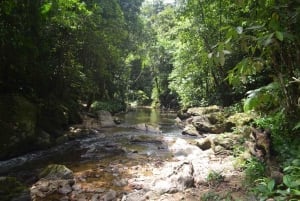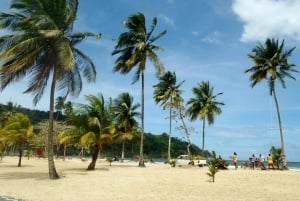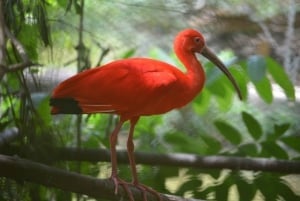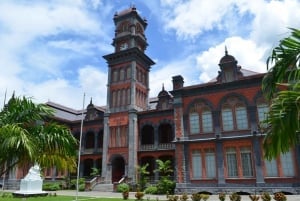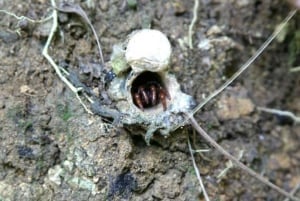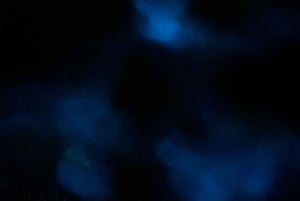Northern Trinidad
North
Northern Trinidad spans from the Caribbean Sea in the West to the Atlantic coast in the North East. The dominating Northern Range, a 2,313-acre reserve of rain forest, encompasses the entire northern coastline. Two peaks rise from the range, Cerro Aripo and El Tucuche, the highest point being 940.3 meters. Hiking is quite popular along the range, as expert guides lead small groups of adventurers towards gorgeous waterfalls and inland ponds every weekend.
There are two roads you can take to cross the mountains of the North Coast. The North Coast Road which begins at Moka Maraval and ends in Blanchisseuse and the other from Arima and takes you along the Blanchisseuse Road through the scenic Arima, Guanapo, Yara and Blanchisseuse forest reserves. It ends when the road meets the North coast road. There is a third option by way of the Valencia Road which joins the Toco Main Road and runs along the Eastern Coastline and ends at the Paria Main Road.
Macqueripe Bay - Recently renovated this hidden gem is just a short drive off the Chaguaramas main. One of the few north coast beaches that is accessible from the North Western peninsular it boasts beautiful landscaping, and has ample parking as well as changing room facilities and Food vendors. Lifeguards are on duty most days and its waters are a lot clearer and calmer than that of the Gulf of Paria located to the west of the island. It is ideal for swimming and snorkeling and you may even catch a glimpse of porpoise swimming close to shore. You can enjoy some Zip Lining before heading down the curved walkway to the beach for a dip in the rejuvenating Caribbean Sea.
Maracas beach - is arguably the most popular beach in Trinidad. Located 45-minutes north of the capital Port of Spain, the beach attracts scores of sunbathers and sightseers on the weekends. Sights on the beach aren’t limited to Coconut trees and tumbling waves. Bird watchers, of the human variety, nestle in the white sandy beach front every weekend, with food and drink, in wait for passing “birds” as beautiful bikini-clad women enjoying the waves are a frequent sight.
Tyrico Bay - tucked away a couple miles down the road from Maracas is one of the more popular surf spots on the island. This secluded mile wide cove provides perfect uninterrupted waves and a qiter atmosphere than Maracas.
Las Cuevas - Head east from Tyrico Bay and you’ll come upon another popular beach at Las Cuevas Bay. Derived from the Spanish word for caves "Las Cuevas" is aptly named for the many caves found on the beach. Nestled in a sheltered bay the water is clearer and calmer than Maracas and provides excellent swimming.
Blanchisseuse - Is a popular weekend getaway for many Trinidadians with it's many holiday homes and guesthouses nestled along the small bays and beaches at the foot of the Northern Range. It is also popular with hikers, with trails that take you over the Blanchisseuse Bridge and into the forest for a 7 mile trot to the secluded Paria Bay. The Blanchisseuse River meets the sea at Paria Bay giving hikers a choice of salt and fresh water swimming. The bay is a favourite for campers over the Easter weekend.
The North Coast Road ends at Blanchisseuse and the remaining 30km of coast can only be accessed by hiking through lush forests and old coffee, citrus and cocoa estates before reaching Matelo
Toco - is where the Caribbean Sea and Atlantic Ocean meet. It is a thriving fast developing fishing village. The lighthouse in Toco is a popular destination for visitors as it provides an excellent destination for wedding and tourism photography. Toco's beaches are a popular surfing spot as the intensity of the waves are sure to test the most skillful board handler.
Matura beach - is a one of the areas the Leatherback, Hawksbill, Olive Ridley, Loggerhead and Green sea turtles visit annually to lay their eggs. You can catch Midnight conservation tours to see these magnificent creatures along the coast during their nesting season. Leatherback (March - July), Hawksbill (May - Sep)
Grande Riviere - During nesting season this mile long beach hosts more than 5,000 leatherback turtles and is arguably the most densely nested leatherback beach in the world. It is also one of the most visited turtle beaches in the world with thousands of visitors coming each year, many being locals.
Life has almost stood still in some villages along the North coast. Maracas, Blanchisseuse and Toco village are as laid back as Trinidad gets. It’s a throw back to life the 1970s where simplicity is the creed and villagers are friendly and honest.


